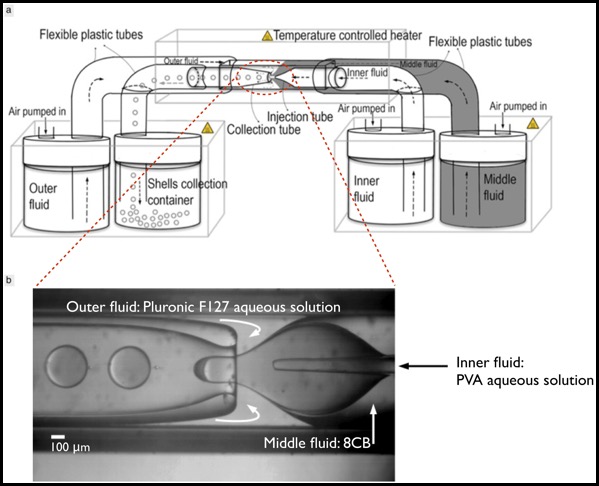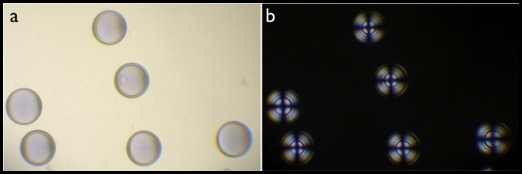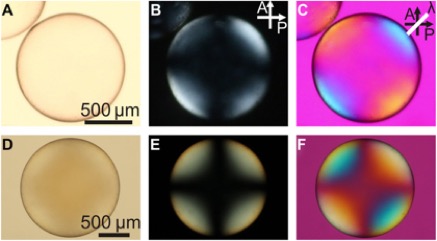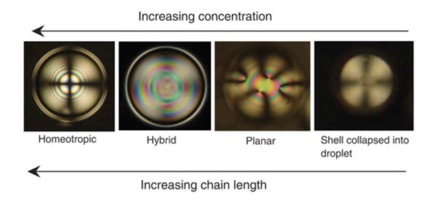Liquid crystal shells produced by microfluidics
One of our major research themes deals with the production and study of fluid shells, or multiple emulsions, primarily of liquid crystalline type. We use an axisymmetric nested capillary microfluidics set-up [1] to prepare the shells, suspended in an isotropic continuous phase, typically water-based.

Schematic diagram (a) and high-speed video optical microscopy image (b) of 8CB spherical liquid crystal shells generated in our capillary microfluidic device system.
The spherical geometry of the shell imposes specific defect configurations in the liquid crystal orientational field, the exact result depending on the prevailing liquid crystal phase, the anchoring conditions at the inner and outer surfaces, the shell thickness and its homogeneity. By varying the inner and outer fluids as well as the liquid crystal material and temperature, the defect configuration can be tuned in different ways.
Our speciality is that we can ensure temperature control at all points of the set-up, allowing us to tune the phase of the liquid crystal, during as well as after the shell production. This way we can investigate shells in many different liquid crystal phases. We are particularly interested in smectic phases, which exist in a great variety with many different properties, sometimes quite unique [2]. The well-defined configurations of defects that must appear in a liquid crystalline shell, with the number defined by the liquid crystal phase and its alignment, makes these shells highly interesting e.g. as a versatile colloid crystal building block [3].

Smectic shells with homeotropic alignment viewed in regular bright-field microscopy (a) and between crossed polarizers (b). In order to verify the shell structure the inner aqueous phase has been dyed blue, as seen in (a). The liquid crystalline nature is verified by the birefringent patterns revealed in (b).
Our publications within this theme have so far focused primarily on the transition between nematic and smectic-A (SmA) phases, under varying alignments and with different shell sizes and thicknesses:
- Towards tunable defect arrangements in smectic liquid crystal shells utilizing the nematic-smectic transition in hybrid-aligned geometries
Hsin-Ling Liang, Rudolf Zentel, Per Rudquist and Jan Lagerwall
Soft Matter, 8, in press, DOI: 10.1039/C2SM07415J (2012) - Nematic-smectic transition under confinement in liquid crystalline colloidal shells
Hsin-Ling Liang, Stefan Schymura, Per Rudquist and Jan Lagerwall
Phys. Rev. Lett., 106, 24, 247801 (2011) - Liquid Crystals in Novel Geometries prepared by Microfluidics and Electrospinning
Hsin-Ling Liang, Eva Enz, Giusy Scalia and Jan Lagerwall
Mol. Cryst. Liq. Cryst., 549, pp. 69-77 (2011)
Below is a movie (from the Soft Matter paper listed above) showing the quite dramatic (and beautiful!) consequences on the texture of the nematic-SmA transition in a hybrid-aligned shell.
A liquid crystalline shell with planar alignment on the inside and homeotropic alignment on the outside, transitioning from the nematic to the SmA phase on cooling.
References
[1] R.K. Sharh, H.C. Shum, A.C. Rowat, D. Lee, J.J. Agresti, A.S. Utada, L.-Y. Chu, J.-W. Kim, A. Fernandez-Nieves, C.J. Martinez, and D.A. Weitz, ‘Designer emulsions using microfluidics’, Materials Today, 11, 4, pp. 18-27 (2008)
[2] J.P.F. Lagerwall, and F. Giesselmann, ‘Current topics in smectic liquid crystal research’, ChemPhysChem, 7, 1, pp. 20-45 (2006)
[3] D. R. Nelson, ‘Toward a tetravalent chemistry of colloids’, Nano. Lett., 2, 10, pp. 1125-1129 (2002).
Three most recent publications

Isotropic-isotropic phase separation and spinodal decomposition in liquid crystal-solvent mixtures, Catherine G. Reyes, Jörg Baller, Takeaki Araki and Jan P. F. Lagerwall , soft matter, 2019,15, 6044-6054

Liquid crystal elastomer shell actuators with negative order parameter, V. S. R. Jampani, R. H. Volpe, K. Reguengo de Sousa, J. Ferreira Machado, C. M. Yakacki and J. P. F. Lagerwall, Sci.adv.,DOI 10.1126/sciadv.aaw2476

Influence of head group and chain length of surfactants using for stabilising liquid crystal shells,
Anjali Sharma and J.P.F. Lagerwall,
Liquid crystals, DOI 10.1080/02678292.2018.1509391More publications can be found here.






